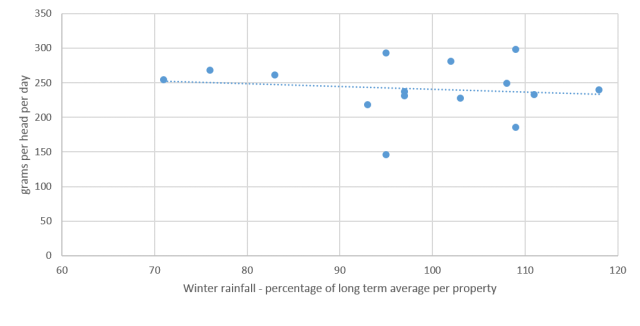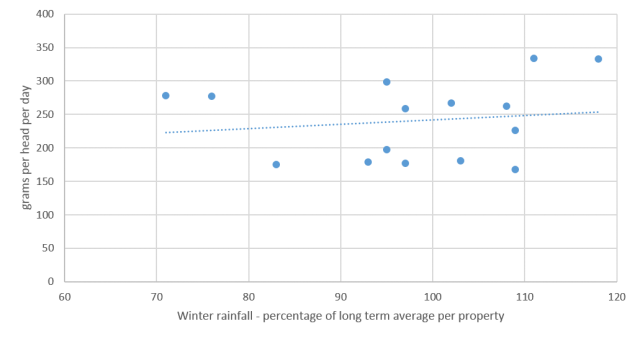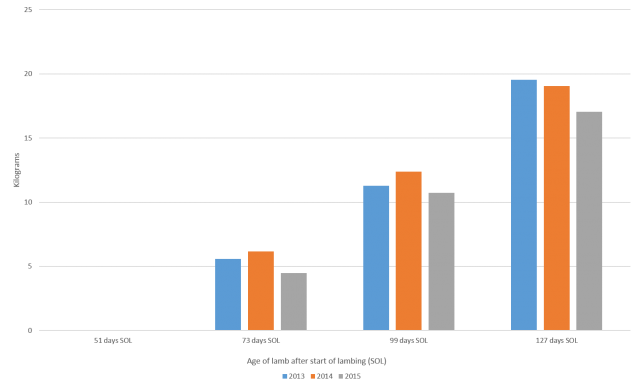Growth of prime lambs grazing green pasture
Danny Roberts, DPIRD, Albany, WA
Author correspondence: danny.roberts@dpird.wa.gov.au
Summary
The live weight gain of unweaned, worm suppressed Merino-terminal sire born lambs was monitored from marking until October while grazing green pasture. The average growth rate over three years of mixed single and twin born prime lambs from 15 flocks on six properties was 243 grams per head per day. Live weight gains were less than expected in most flocks from late August to October with only five flocks (33%) recording more than 270 grams per head per day during this period.
Introduction
The information presented is from a project investigating the effect of winter worm burdens on prime lambs growth rates funded by MLA (B.AHE.0072). The 15 monitored flocks were on six properties located at Broomehill, Kendenup, Narrikup, Manjimup, Pingelly and Esperance.
Method
Prime lambs born to Merino ewes, mated to different terminal sires, were monitored from early June to late October on six properties from 2013 to 2015. The Merino ewes had not been pregnancy scanned and the selected unweaned prime lambs in each flock were a mixture of single and multiple births.
In an attempt to standardise the adjusted age of the lamb from each flock, repeated weighing of an average 45 lambs per flock occurred on days 51, 73, 99, and 127 after the start of lambing (SOL). Calculation of growth rates occurred for three periods – from day 51 to 98 (June to mid-August); from day 99 to 127 (late-August to October); and from day 51 to 127 after SOL (June to October). The cohort contained 50% males and 50% females. Lambs received selenium and cobalt injections and multiple anthelmintic drenches. As the unweaned lambs were worm suppressed, they were not affected by winter worm burdens. The prime lambs that were slaughtered on day 192 gained an average of 27.7 kg from lamb marking (day 51 after SOL).
Records from weather stations on or near each property of past rainfall from April to October (winter growing season rainfall) allowed calculation of the percentage of the long term average rainfall received in 2013, 2014 and 2015.
Results
The average weight of the lambs was 36 kg (2013), 35 kg (2014) and 34 kg (2015) by October or 127 days after the start of lambing (SOL). The average gain in live weight from lamb marking to October was 19.5kg (2013), 19 kg (2014) and 17 kg (2015) as shown in figure 1. This period represents 67% of the cumulative average weight gain achieved before the prime lambs were sent to slaughter.
The decline in average growth rate of the prime lambs from marking to October mirrors the decline in the percentage of long term average winter rainfall received in 2013, 2014 and 2015, as shown in Table 1.
| Year | Average grams per head per day | Percentage of long term average winter rainfall |
|---|---|---|
| 2013 | 256 | 105% |
| 2014 | 250 | 103% |
| 2015 | 223 | 87% |
| 2013 to 2015 | 243 | 98% |
In 2015, the decline in average growth rates of lambs occurred in the 51-98 day period (June to mid-August) with a 10% reduction compared to the average of 2013 and 2014. A further 13% reduction occurred for the 99 – 127 day period.
It appears that the grazing management of each flock was critical. Some flocks achieved higher average growth rates irrespective of winter rainfall percentage, as shown in figure 2. The trend line indicates that most flocks did not gain weight at higher growth rates during years with higher percentage of winter rainfall.

Aspirational growth rates of 300 grams per head per day are often used as a benchmark for prime lamb production. In this study, individual flocks achieved more than 300 grams per head per day in only 13% of 30 measurement periods, and none in consecutive periods.
In prime lambs, the highest weight gains would most likely occur from late August to October. Average growth rates of lambs greater than 270 grams per head per day is the benchmark used in this study. Five flocks (33%) had average growth rates above 270 g/h/d for this period, as shown in figure 3. The percentage of winter rainfall received on these five properties ranged from 71% to 118% of the long term average.

Discussion
The information from this study pertains to unweaned, worm suppressed Merino-terminal sire born lambs. Grazing management was more critical for weight gain than the relative winter rainfall each property received. Only five flocks (33%) achieved gains of greater than the 270 grams per head per day benchmark from late August to October over the three years of this project. During this period, pasture growth rates are increasing, reducing any restrictions of Feed-On-Offer, pasture energy and protein content is relatively high and fibre content is low. All of these factors support high growth rates. Achieving the 270g target during this period is important because growth rates declined from October in all 15 flocks. Improving growth rates while grazing green pasture is a potential way to increase the final live weight of prime lambs at slaughter.

